Yves here. Green New Deal boosters tout all the great jobs that the energy transition will create. They overlook employment losses and/or simply assume those workers will be able to step into new roles. The post below suggests the skill difference means that may not be the case. And “let them eat training” remedies don’t have a great record of success.
By Orsetta Causa, Senior Economist Organisation for Economic Co-Operation and Development (OECD); Maxime Nguyen, Consultant Organisation for Economic Co-Operation and Development (OECD); and Emilia Soldani, Economist Organisation for Economic Co-Operation and Development (OECD). Originally published at VoxEU
Greening the economy will entail the contraction of high-polluting jobs. This column presents new OECD research using labour force data from a large sample of European countries that suggests green and high-polluting jobs are unequally distributed across socioeconomic groups. Green jobs are associated with higher educational attainment, high-polluting jobs with lower educational attainment, and women are underrepresented in both green and high-polluting jobs. Minimising transition costs – with targeted policies that facilitate reskilling and match workers with high-demand jobs – will be crucial to accelerating decarbonisation while reducing displacement penalties for affected workers.
Greening the economy refers to the transition towards more sustainable and environmentally friendly practices in various sectors (Pisu et al. 2022). This can significantly impact labour market outcomes and inequalities, including job creation and transformation, skills demand and training, as well as territorial disparities. While aggregate employment effects could be relatively small, the combination of policies and technological change needed to bring about decarbonisation will require reallocation of production factors, which will have distributional effects, possibly increasing inequality.
One lesson from the impact of globalisation/technological change is that moderate aggregate effects or even aggregate gains can go hand-in-hand with concentrated losses for certain groups of workers and their communities, especially when the changes take place rapidly (Ottaviano et al. 2021). Preventing this from happening in the green transition requires understanding labour market dynamics and elaborating appropriate policy responses. Such policies would improve the allocation of workers and their deployability – for instance, towards performing green tasks – as well as working to manage and minimise the scarring effects associated with job losses in polluting industries. Understanding and addressing distributional implications of climate policies is also fundamental for political acceptability (Stantcheva et al. 2022).
Based on our two recent papers (Causa et al. 2024a, 2024b), in this column we deliver new evidence and stylised facts on the incidence across selected European countries of green and high polluting jobs, their geographical distribution, and their incidence among different categories of workers. By identifying the characteristics of affected workers, we provide insights on how public policies can support workers and a just transition to low-emission economies.
A New Empirical Framework to Study the Labour Market Effects of the Green Transition
The starting point is a new empirical framework to study the labour market effects of the green transition, contributing to the literature and debate along the following dimensions: (1) the cross-country comparative perspective, (2) the use of individual/worker-level data, and (3) the empirically based granular analysis. Most of the empirical literature in this area has focused either on single countries, in particular the US thanks to the availability of high-quality ready-to use data, or on cross-country aggregate data.
The analysis builds on established measurement approaches for identifying ‘green’ and ‘high-polluting’ jobs, in particular O*NET (2010) based on US information. The framework is worked out and revisited to be applied to harmonised European labour force survey data. To overcome the limitations of applying US-based metrics, this paper proposes a new approach to identify ‘high-polluting’ jobs, based on European emission data by country and industry. The main advantage of relying on country-specific data on emissions is that it allows the capture of cross-country heterogeneity in emission intensity by industry. The analysis shows that these differences can be very large: for instance, in electricity, gas, steam, and air conditioning supply activities, the most polluting countries emit four times more GHG per worker than the least polluting countries.
Stylised Facts About Green and High Polluting Jobs
The Big Picture
Based on the newly developed empirical approach, Figure 1 reports the estimated shares of green and high polluting jobs across European countries over the period 2011–2019. The main highlights are:
- The estimated share of green jobs is 8% on average across the countries covered. The incidence of green jobs varies between around 10% in the UK and Estonia, and 5% in Greece.
- The estimated share of high polluting jobs is around 4% on average across the countries covered. This share varies from around 9% in Czechia and the Slovak Republic to 2% in Austria and Portugal.
- Over the last decade, labour markets have not become significantly greener, on average, across the European countries covered. There has been no significant change in the share of green and high polluting jobs; some countries have actually experienced an increase in the incidence of high polluting jobs.
Figure 1 Green and high polluting jobs across European countries, 2011–2019
Share of total employment (%)
A) Green jobs
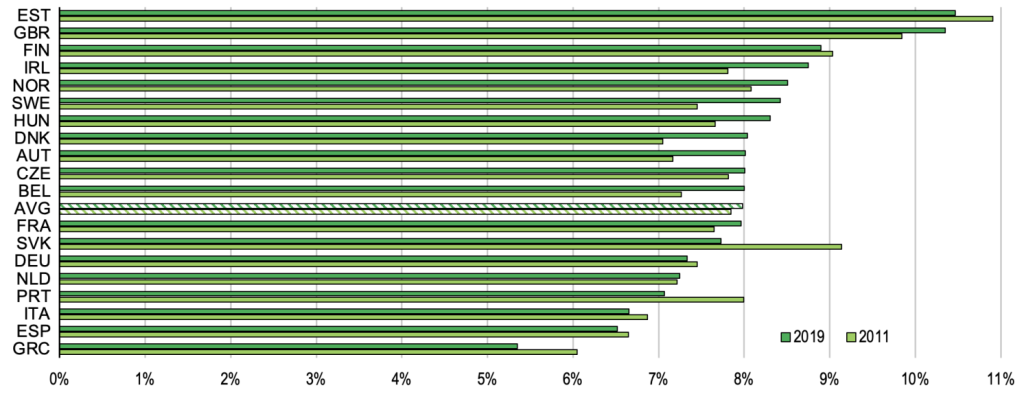
B) High polluting jobs
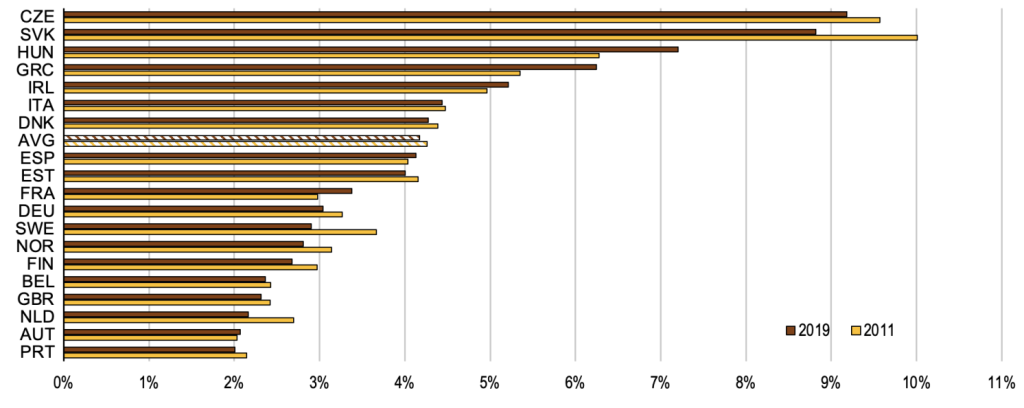
Note: The estimated employment share of green jobs in Belgium is 7.3% in 2011 and rises to 8% in 2019, while that of high polluting jobs is stable at 2.4%. See text for definitions.
Source: EULFS and authors’ calculations.
Going Granular
A more granular picture about green and high polluting jobs, focusing on their incidence across different socioeconomic groups, delivers the following insights:
- In all countries, women are less likely to hold green jobs (Figure 2, Panel A). For example, in the UK, 15% of male workers are employed in green jobs, more than double the rate (6%) for female workers. This largely reflects the over-representation of women in service industries like hospitality, health, and education, which are mostly neutral from an environmental perspective. By contrast, men are overrepresented in manufacturing, construction, and utilities (the industries with the highest share of both green and high polluting jobs).
- Workers with higher levels of education are more likely to hold green jobs relative to workers with middle and lower levels of education (Figure 2, Panel B). In Germany, 11% of workers with high levels of education are employed in green jobs, which is almost double the rate (6%) for workers with low or middle levels of education. This pattern is in line with evidence from the US showing that green occupations are, on average, higher-skill and less routine-intensive than non-green occupations and that they require high-level analytical and technical skills linked to technology (Vona et al. 2018).
Figure 2 Green jobs across socioeconomic groups, share of group employment in 2019
A) Gender
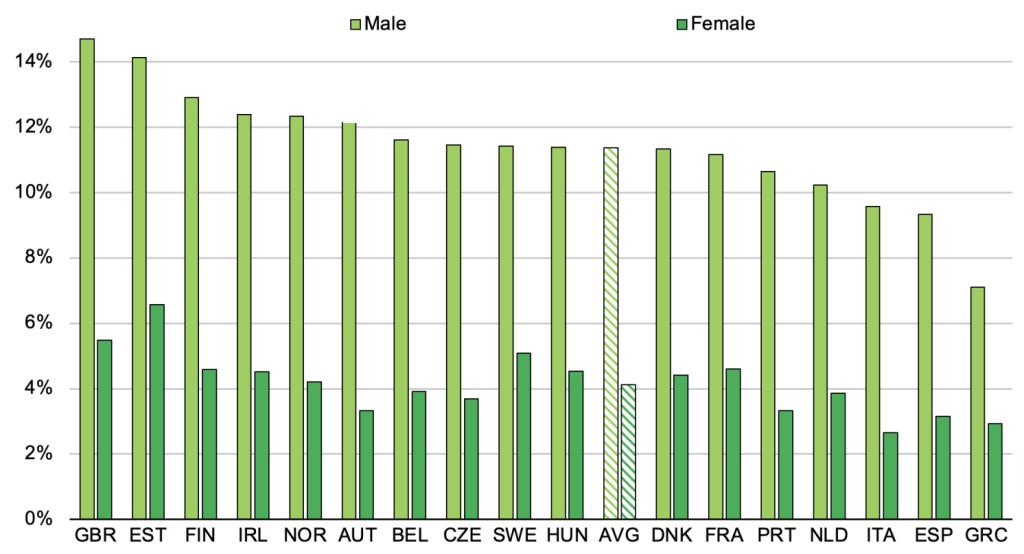
B) Educational attainment
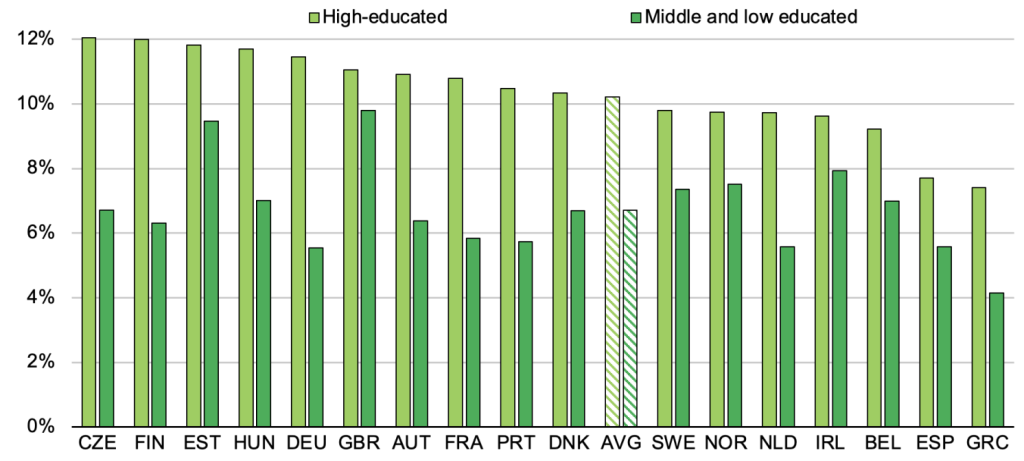
Note: In France, 11% of employed males hold green jobs, by contrast with 4.6% of employed females. In Germany, 11% of workers with higher educational attainment hold green jobs, by contrast with 5.6% of low and middle educated workers.
Source: EULFS and authors’ calculations.
The distribution of green and high polluting jobs also varies between different areas, especially between urban and rural areas; in particular, high polluting jobs are systematically overrepresented in rural areas (Figure 3). This is in line with recent OECD work on the green transition and local economic development (OECD 2023).
Figure 3 The prevalence of high polluting and green jobs in rural and urban areas, 2019
Ratio between the share of high polluting/green jobs located in rural /urban areas and the share of all jobs located in rural/urban areas
A) High polluting jobs
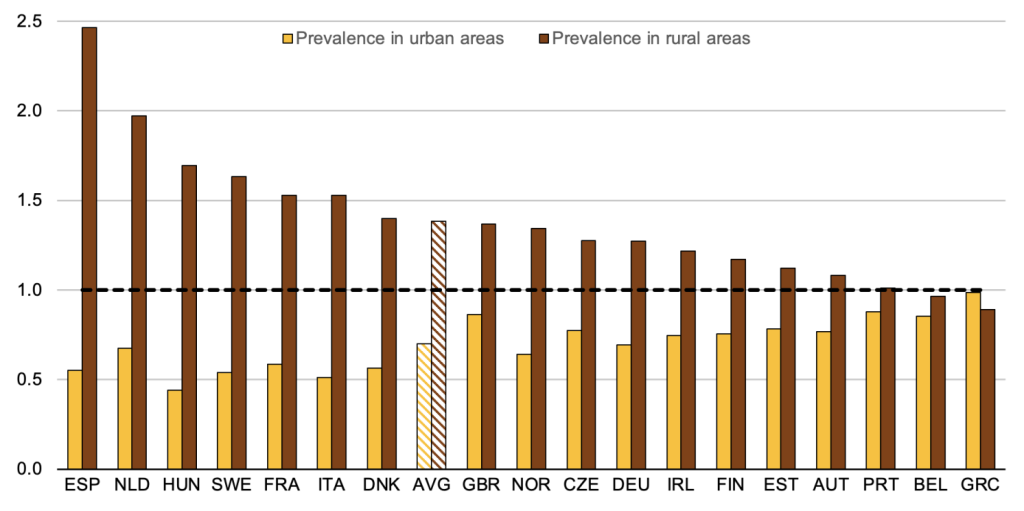
B) Green jobs
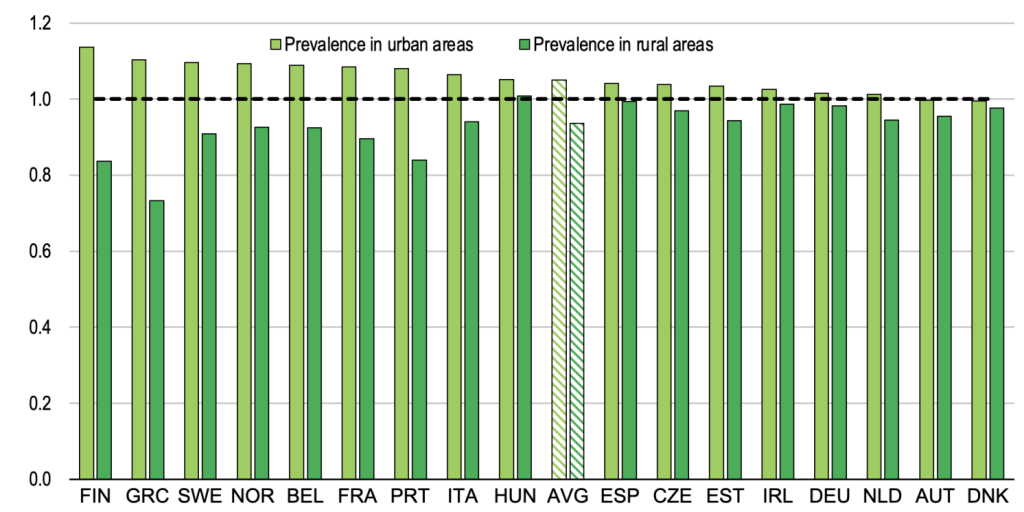
Note: In Spain, high polluting jobs are more than twice as prevalent in rural areas than in the whole country, while they are half as prevalent in urban areas.
Source: EULFS and authors’ calculations.
The quality of jobs is not formally included in the measurement of green or high polluting jobs, the literature in this area being still at an early stage for reaching consensus on measuring quality alongside job quantity. Yet, labour force survey data can be mobilised to shed some light on this important issue. One key dimension in the context of the green transition is workers’ access to training: this is an especially relevant aspect of job quality insofar as moving towards greener activities may require requalification. Interpreting the results of this analysis with caution due to the simple bivariate nature of the exercise, the evidence suggests that in all countries covered, workers employed in high polluting jobs are less likely to participate in training relative to workers employed in green and other jobs (Figure 4). This raises policy concerns in the context of the green transition to the extent that workers in high polluting jobs are more likely to be displaced and to require requalification and other forms of training to facilitate labour market mobility.
Figure 4 Participation to training among workers employed in green and high polluting jobs, 2019
Percentage of workers who have attended non-formal education learning during the last four weeks
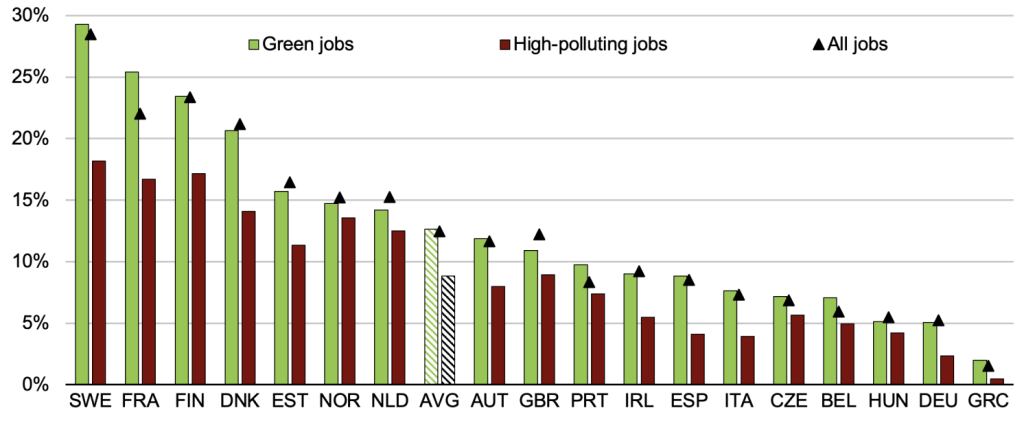
Note: In France, 25% of workers in green jobs have participated to non-formal training during the last four weeks, by contrast with 17% of workers in high polluting jobs.
Source: EULFS and authors’ calculations.
Policy Implications
The descriptive evidence in this column points to the policy challenges associated with greening the economy from a labour market perspective, reflecting several pieces of evidence, in particular: 1) the low progress achieved in terms of green jobs expansion, notwithstanding the still uncertain measurements and data, 2) the inequalities in terms of the socioeconomic composition of green jobs, especially the pervasive under-representation of women and workers with lower levels of education, and 3) the spatial divides associated with the geography of high-polluting and green jobs, particularly the concentration of high-polluting jobs in rural areas. In this context, achieving progress in reaching environmental objectives will require identifying workers and communities at risk of displacement and taking policy action to accompany individuals and localities navigating the transition. This includes well-designed and targeted active labour market policies, for instance to support job search, training, and requalification, and to remove obstacles to geographical relocation. At the same time, place-based policies will also be needed to support economic redeployment and social stability in the areas affected by the contraction of high-polluting production processes.
See original post for references


This talk of the Green Jobs we are all supposed to aspire to gives me the creeps. In this piece, I particularly like the phrase ¨Stylized Facts¨. What does one do to a fact to stylize it? I may be late to the party, but I have trouble figuring out what exactly a Green Job is. Offhand, from reading this piece I assume it is one done by some educated PMC person sitting in a comfortable air conditioned office tapping away on a keyboard all day before commuting (being Green this would be via electric car or rail) twenty miles to their oversized home. Meanwhile, some peon who never finished college is working on a farm, where he lives, feeding livestock, cleaning out stalls, plowing the fields, burning firewood, and doing lots of other dirty work, is not Green. Even though the uneducated peon may actually be farming in a sustainable, ecologically respectful way I don´t think he meets the Green test assumed by this author.
This paper´s treatment of the subject is basically PMC word salad. Farming, mining, heavy manufacturing, fishing and the like are essential to modern life. I acutally think that the activity of sitting in the AC doing what could be called a Bullshit Job (producing nothing useful) is the dirtiest kind of job. This kind of navel gazing is not helpful. All jobs should be green jobs, which is to say that they should all be done with as much respect for the environment, for what is possible for people to do as possible. As the song goes, ¨The farmer is the man, the farmer is the man, the farmer is the man who feeds us all:¨
Aye. The lack of definition regarding “green” jobs vs “dirty” jobs is problematic. Are 15% of men in the UK really working in green energy? That seems extraordinarily high to me. According to the IEA (at https://www.iea.org/reports/world-energy-employment/overview), “energy employs 65 million people worldwide and accounts for 2% of global employment, relatively evenly distributed across fuel supply, power sector, and end uses.“
Hmmm… I actually found the technical paper: https://www.oecd-ilibrary.org/deliver/dce1d5fe-en.pdf.
On page 14, the greenest occupations are “refuse workers”, “Manufacturing, mining, construction, and distribution managers”, and “Engineering professionals (excluding electrotechnology)”. And simultaneously on page 16, the highest-polluting occupation is “Manufacturing, mining, construction, and distribution managers”. The classifications seem rather a mess.
To their credit, though, the authors noted near the end: “The analysis of green jobs is hampered by the lack of a comprehensive and homogeneous European based taxonomy of green jobs.” Yep.
I picked up on the same thing; they mention the US government’s O*NET database, but I wasn’t aware that had categorized jobs by pollution level. Which leads to the next obvious question: do we really trust the US government’s methodology?
Like you, when I first saw the article title, I figured a “green job” was something directly linked to ecology or a special class of technologies. Organic farmers, recycling, environmental remediation, renewable energy, field biology, that sort of thing.
The figures they throw out seem really weird though. Like I would think chemicals, steel, and other manufacturing would inevitably be “high-polluting”, but then Germany ranks relatively low on their chart. And the figures are from 2019 so this is supposedly before COVID or Nordstream.
In the OECD, green jobs are defined as “jobs where at least 10% of tasks directly supports sustainable development “, https://www.oecd.org/newsroom/action-on-jobs-skills-and-regional-disparities-vital-for-the-green-transition.htm#:~:text=%E2%80%9CBridging%20the%20Great%20Green%20Divide,2021%2C%20with%20significant%20differences%20within
I am not a fan of their distinction between green and brown jobs, for a myriad of reasons. I am working in a circular construction project (www.recreate-project.eu) and I wonder where deconstruction/construction workers are. It depends on the materials they use (reused or virgin) and whether the machines work on (green) electricity or diesel. The OECD definition is far too coarse.
About the reskilling: in our project, which involves anything from deconstruction to architects’ work (i.e. the whole value chain) and it seems that in construction it is rather a reconfiguration of existing skills rather than a need for reskilling. Especially the “blue-collar” workers use the same skills as always, but for a different goal. Same with structural engineers and architects. For me as a labour scholar, there is surprisingly little that needs reskilling. Good plans, yes, more collaboration, yes, but there wasn’t any work “missing”.
This analysis also doesn’t seem to concern itself with what kind of jobs on what kind of projects would have an overall up-greening effect on the overall eco-body political-cultural economic.
For example, how much carbon is emitted by mining a ton of high plant-growth nutri-power multimineral rock, grinding it flour-fine, and using an airplane to spread it thinly over a set area of forest land? Now . . . how much would that multi-mineral rock flour-dust accelerate the growth of that set area of forest land? If that forest land’s accelerated growth would suck down more than a ton of carbon from the sky-volume above that set area of forest land, then that project would have a net up-greening effect on the whole overall system. And if it worked out that way, then to mine, grind, fly and spread that ton of rock over that set area of forest would be an overall net-net green job.
I don’t know if it would work out that way. But if it did, then it would ( be overall green). Someone should do all the relevant research to see if this would be net carbon resuckdown. Maybe somebody already is. ( The research would be tedious, painstaking and timetaking enough to do that somebody would have to be paid to do it. No one is going to do it for free, least of all an amateur science buff sitting at a keyboard in a public library on his off-time from work.)
What the EU is working towards with CSDR and the EU Taxonomy is the need to show (to investors and possibly tax authorities) that firms are working towards a sustainable future. Therefore LCA and LCC-measurements are needed for production processes, indeed life-cycle carbon (and let’s not forget other bad stuff like Nitrogen).
Your hunch is spot-on – the whole value chain should ideally be transparent in the carbon emissions. But for example the electronics industry relies on rare earth materials mined in Africa, where actually other sustainability issues are relevant. So it is not only carbon, in these green / brown jobs, that one should be concerned about but also other issues related to the planetary boundaries.